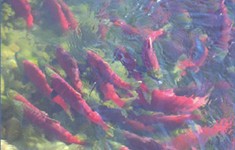It appears as though  the Fraser River sockeye salmon season is going to be a disappointing one. As of 11 August, according to data from the Alaska Department of Fish and Game, only 50,000 fish had been landed, lower than both the 5-year average and at the same time last.
the Fraser River sockeye salmon season is going to be a disappointing one. As of 11 August, according to data from the Alaska Department of Fish and Game, only 50,000 fish had been landed, lower than both the 5-year average and at the same time last.
While it’s not the disaster of 2009 — when barely 1 million fish returned to the Fraser River sockeye salmon fishery, compared to the 10 million fish projected — the roller coaster that can be wild salmon harvests has to have raised some concerns among buyers.
One of the first solutions that comes to mind is to have aquaculture fill in the supply gaps. According to a 2012 United Nations’ Food and Agriculture Organization report, an increase in global seafood production will come mainly from aquaculture production, which is projected to grow 33 percent by 2021. Wild production is only projected to grow 3 percent between 2012 and 2021.
It’s not as though aquaculture is without it’s own issues. ISA crashed Chile’s salmon operations in 2007 and it cannot keep growing at its current pace. FAO numbers show the sector growing at an annual rate of 5.8 percent for the past decade, which is projected to slow to 2.4 percent from 2012 to 2021.
And aquaculture doesn’t have the best reputation with consumers, a 2011 Mintel survey showed only 25 percent of consumers believe that farmed fish is the same quality as wild fish.
One move that may help improve that reputation and connect the two segments is the recent formation of the Global Salmon Initiative. The 15 companies’ — representing 70 percent of global farmed salmon production — commitment that 100 percent of their production will be certified by the Aquaculture Stewardship Council by 2020 should measurably reduce the impact of salmon production on some of the world’s most ecologically important regions.
Another is the recent development of “vegetarian fishmeal,” developed by researchers at the University of Maryland Center for Environmental Science’s Institute for Marine and Environmental Technology. The developers replaced fishmeal with a blend of plant protein sources, with no difference in the growth rate of the fish.
Wild salmon and farmed salmon need each other. Balancing out supply issues would keep fish in front of consumers year round. Most consumers don’t understand the wild versus farmed fish controversy, which can lead to confusion, which doesn’t help when consumers are trying to choose what protein to serve for dinner that night.
One doesn’t have to replace the other but they compliment each other to fill the supply gap. Work should be done by both sides to make it farmed and wild, instead of farmed versus wild.
 the Fraser River sockeye salmon season is going to be a disappointing one. As of 11 August, according to data from the Alaska Department of Fish and Game, only 50,000 fish had been landed, lower than both the 5-year average and at the same time last.
the Fraser River sockeye salmon season is going to be a disappointing one. As of 11 August, according to data from the Alaska Department of Fish and Game, only 50,000 fish had been landed, lower than both the 5-year average and at the same time last.While it’s not the disaster of 2009 — when barely 1 million fish returned to the Fraser River sockeye salmon fishery, compared to the 10 million fish projected — the roller coaster that can be wild salmon harvests has to have raised some concerns among buyers.
One of the first solutions that comes to mind is to have aquaculture fill in the supply gaps. According to a 2012 United Nations’ Food and Agriculture Organization report, an increase in global seafood production will come mainly from aquaculture production, which is projected to grow 33 percent by 2021. Wild production is only projected to grow 3 percent between 2012 and 2021.
It’s not as though aquaculture is without it’s own issues. ISA crashed Chile’s salmon operations in 2007 and it cannot keep growing at its current pace. FAO numbers show the sector growing at an annual rate of 5.8 percent for the past decade, which is projected to slow to 2.4 percent from 2012 to 2021.
And aquaculture doesn’t have the best reputation with consumers, a 2011 Mintel survey showed only 25 percent of consumers believe that farmed fish is the same quality as wild fish.
One move that may help improve that reputation and connect the two segments is the recent formation of the Global Salmon Initiative. The 15 companies’ — representing 70 percent of global farmed salmon production — commitment that 100 percent of their production will be certified by the Aquaculture Stewardship Council by 2020 should measurably reduce the impact of salmon production on some of the world’s most ecologically important regions.
Another is the recent development of “vegetarian fishmeal,” developed by researchers at the University of Maryland Center for Environmental Science’s Institute for Marine and Environmental Technology. The developers replaced fishmeal with a blend of plant protein sources, with no difference in the growth rate of the fish.
Wild salmon and farmed salmon need each other. Balancing out supply issues would keep fish in front of consumers year round. Most consumers don’t understand the wild versus farmed fish controversy, which can lead to confusion, which doesn’t help when consumers are trying to choose what protein to serve for dinner that night.
One doesn’t have to replace the other but they compliment each other to fill the supply gap. Work should be done by both sides to make it farmed and wild, instead of farmed versus wild.





